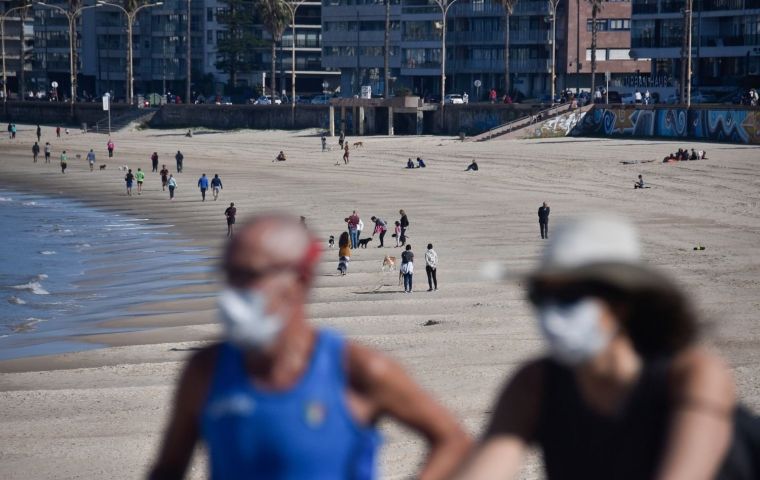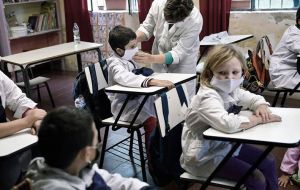MercoPress. South Atlantic News Agency
Uruguay is winning against Covid-19: This is how
 A normal scene in the capital Montevideo, people with face masks.
A normal scene in the capital Montevideo, people with face masks.  Unlike most Latin American presidents, Lacalle Pou asked rather than ordered people to stay at home to protect the population, the oldest in Latin America.
Unlike most Latin American presidents, Lacalle Pou asked rather than ordered people to stay at home to protect the population, the oldest in Latin America.  Children attending school and keeping to sanitary guidelines
Children attending school and keeping to sanitary guidelines by Luke Taylor, The British Medical Journal – Latin America continues to suffer some of the worst tolls of Covid-19, with over seven million recorded infections accounting for nearly half of all daily deaths. But in the region's Southern Cone there is a clear outlier wedged between Brazil to the east, with over 3.5 million confirmed cases, and Argentina to the west, with half a million.
Somehow, Uruguay has a lid on the pandemic. Its relatively small population of 3.6 million made controlling the transmission of covid-19 easier but never guaranteed its success—Panama, home to four million in Central America, has recorded over 100 000 cases and 2000 related deaths.
Uruguay as of Friday September 24, has recorded 1967 infections and 47 deaths, despite beginning to reopen some schools in April and no mandatory stay-at-home order. Many South American countries also acted swiftly with stricter obligatory lockdowns—among them neighboring Argentina—but still saw infections soar.
“Uruguay continues to provide hope” for the region, says Marcos Espinal, the head of the Communicable Diseases and Health Analysis department at the Pan American Health Organization (PAHO). The country’s response could offer various lessons to the region and the world, among them how to test more efficiently using a system first pioneered to tackle syphilis during the second world war.
Less than two weeks into his new job as Uruguay’s president, Luis Lacalle Pou acted promptly when Uruguay’s first case of covid-19 was confirmed in the capital of Montevideo on 13 March. Lacalle Pou announced that all public events and potential centers of crowding such as bars, churches, and shopping centers would be shut down. Schools were also closed, along with the country’s 1000 km porous border with Brazil, the epicenter of the pandemic in the region. Unlike most Latin American presidents, Lacalle Pou asked rather than ordered people to stay at home to protect the population, the oldest in Latin America.
The swift action of the government slowed the spread of the virus and bought the country vital time to prepare its hospitals and testing system, says the team of scientists advising it. It also meant they could stop the virus’s spread before it became exponential as it did in the hardest hit nations.
“By acting really fast we were able to completely identify and stop the transmission chain of the disease in every [outbreak],” says Rafael Radi, a biochemist at Montevideo’s University de la Republica leading the government’s advisory group.
Epidemiologists traced the first outbreak to a wedding, where all attendees were tested and suspected infections isolated within 24 hours. The same approach was employed at the three subsequent outbreaks: a mental health care hospital, a care home for the elderly, and the city of Rivera, bordering Brazil. The result was that most local transmission chains have been controlled at the second or third ration of contacts,4 before their spread accelerated.
The urgency and scientific grounding of the government’s early decision making characterized the country’s response ever since—and even before the first case was detected. All decisions passed through a cross-disciplinary committee of scientists who refocused their research to covid-19.
“The alignment of decision makers, scientists, and national health authorities was perfect and clearly with great timing,” says Gonzalo Moratorio, a virologist directing Uruguay’s covid-19 testing unit.
Where Uruguay succeeded and other nations did not was testing. It has tested 233.7 people for every confirmed case of covid-19,5 compared with 1.7 in Argentina, 1.9 in Mexico, and 3 in Colombia. Though much of South America has tried to follow WHO recommendations to test, trace, and isolate, they have struggled to keep up with the scale of the spread.
The key was developing a nationally produced testing kit, says Gonzalo Moratorio, who led the team which developed it.
Latin America relies largely on medical supplies from abroad, leaving it vulnerable to market shortages. When supplies of commercial diagnostic kits and reagents bottlenecked in March under protectionist policies and a surge in global demand, the region was left to compete with the rest of the world to procure PCR tests.
“The US and even Europe were kind of sealing off the biotech industry,” Moratorio says. “What we did was assemble various things and combine our know-how to become independent.”
Developing a national testing kit shielded Uruguay from market shortages and helped it ramp up its diagnostic capacity from around 200 tests per day in March to nearly 1000 by the end of May. Over half of its PCR tests were manufactured domestically.
The kits and testing methodology were shared with the “covid-19 diagnostic lab network”: 24 laboratories created in a matter of weeks in research institutes, public hospitals, and academic laboratories across the country. Decentralizing testing from the capital cut testing time down from several days to less than one, Moratorio says. And Uruguay never fell behind in testing despite any acceleration of cases.
Pool testing
Once the prevalence of the infection was low, Uruguay began pool PCR testing to maximize efficiency. Instead of testing each individual sample, multiple samples are pooled and tested together. Ideally the test is negative, allowing that population to be cleared of the disease, but should it test positive the group is broken down into several other groups or each individual sample until the positive sample is identified.
“It's super useful because, by pool testing, we can screen populations like teachers, which mean we could open schools without mandatory quarantine,” Moratorio says. The same approach has been used with care homes, medical staff, and football teams to facilitate a return to normality more quickly and at lesser cost.
Pool testing has been successful in tackling covid-19 in other countries such as Rwanda where testing infrastructure is lacking and individual testing is relatively expensive, says Sema Sgaier, at the Surgo Foundation. “PCR testing is not cheap, and that’s why Rwanda has been successful deploying pool testing early on,” Sgaier says on the country, which has recorded less than 4000 cases and 16 deaths to date.
The technique is useful once the prevalence of the virus is low—in Uruguay’s case below 1%. It is not useful when the virus is prevalent as it would mean retesting too many individuals, negating the efficiency of pool testing.
To further enhance testing efficiency, matrix pooling was used, a technique whereby samples overlap in rows and columns. The strategy makes it easier to find the infected individual in a positive sample in the second round of testing without having to test each sample individually.
Using a “10×10” strategy allowed laboratories to analyze 1000 samples by running 200 molecular tests, reducing the number of tests required by 80% compared with individual testing, says Uruguay’s test group.
Matrix pooling was one of several tools that have allowed Uruguay to move closer to normality safely and quickly, but behind it is a greater success which has underlain the country’s progress, Moratorio says.
“It’s thinking outside of the box and being able to reshape and adapt methods and resources we had at the beginning, and new ones we built, that was key to fighting the pandemic,” he says.




Top Comments
Disclaimer & comment rulesCommenting for this story is now closed.
If you have a Facebook account, become a fan and comment on our Facebook Page!